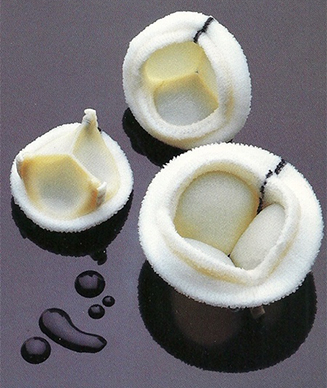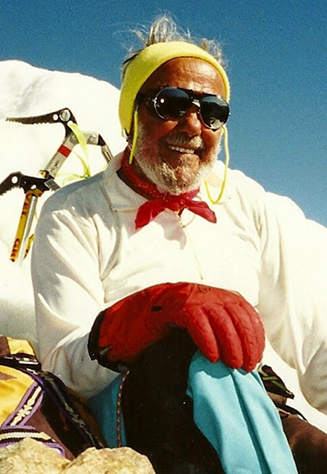“I will not lose; either I win or I learn” – Marian Ionescu, circa 1971
The pericardial heart valve concept is the remarkable legacy of a man and his genius. His single most defining contribution has changed the course of cardiac surgery over the last half a century and benefitted millions of patients worldwide. Since the initial design by Hufnagel of the ball-cage valve implanted in the descending thoracic aorta (1953) to correct a regurgitant aortic valve, nearly 150 valves have been designed and tested. None has stood the test of time as well as the pericardial valve (figure 1). Since the first successful human implant of the pericardial valve in the mitral position in 1971, 10 million of these have been implanted worldwide. Pericardial valves now constitute 80% of all implanted valves. The invention has driven a multi-billion dollar industry that today forms the backbone of the healthcare technology sector.

Material choice
It was a stroke of Ionescu’s genius, industry and tenacity that among all the materials available at the time, such as polyurethane, ivalon, fascia lata and dacron, he finally chose glutaraldehyde-treated bovine pericardium to construct his valves. To arrive at this point Marian Ionescu had already been on a 14-year journey of invention, which started in 1957 and included the three-pronged coronet design of the aortic valve used to this day. Over the last five decades, we have now realised that the pericardium has four unique defining characteristics – pliability, durability, resistance to infection and thromboembolic resilience – that make it unique among materials for valve design. It can also be crimped, which make its use possible for catheter-based valves – all of which are pericardial. Ionescu’s original concept of a pericardial valve was reimagined using percutaneous catheter delivery by Alain Cribier in Rouen, France in 2002. The Food and Drugs Administration (FDA) granted its approval in 2012 for commercial use, which spawned a second revolution of the pericardial valve concept. These pericardial catheter-based valves have already outpaced surgical valve replacements, and 280,000 are set to be implanted each year by 2025. What Ionescu recognised 50 years ago about the unique properties of pericardium, has been borne out by five decades of scientific data, evidence and validation from millions of implanted pericardial valves around the world.

The start
This successful journey started on 4 April 1971, in Leeds, UK, where Marian Ionescu implanted the first pericardial valve in the mitral position. This was designed and perfected by him, and handsewn by his wife and cardiologist, Christina Ionescu. The Starr-Edwards ball-cage valve and the Bjork-Shiley tilting-disk valves in the previous decade had both been mechanical valves with problems of noise, thromboembolism, and structural fatigue, and carried the bane of lifelong anticoagulation. Despite multiple design modifications, the Bjork-Shiley valve was discontinued by Pfizer in 1987 and the Starr-Edwards valve by Edward Lifesciences in 2007. The pericardial valve, from its very inception, circumvented all these problems, and unlike the mechanical valves, which were designed by engineers, the pericardial valve was designed by a surgeon. Between 1971 and 1976, 212 patients received these hospital-made valves. None of the patients was anticoagulated beyond the initial six weeks. Clinical and laboratory tests, haemodynamic investigations, at rest and during exercise, were performed on 110 patients (51 aortic; 44 mitral; 12 multiple and three tricuspid valve replacements). Nineteen of these (13 aortic and six mitral) were subjected to sequential haemodynamic studies at intervals of approximately 1, 3.5 and 5.7 years post-implantation. These studies demonstrated excellent function, better than with porcine valves and equal to the best mechanical valves.1 Later, issues of tissue abrasion, and cusp tears due to stresses on the pericardium at the struts, were managed by unique design modifications, including double-layer reinforcements and internally mounted commissures.
Further discovery
The ‘father of the pericardial valve’ – Ionescu himself made another astounding discovery in 1985. After statistical analysis of the two largest series of patients with the Ionescu-Shiley pericardial valves implanted between 1971 and 1987 in patients of all age groups (Denton Cooley’s series of 2,720 patients and Marian Ionescu’s series of 1,171 patients), he found that calcification of the pericardial valves occurred more rapidly in younger patients than in those older than 70 years. Calcification, by this time, had been identified as the main cause of long-term structural valve degeneration (SVD) and failure. The use of various anticalcification treatments during manufacture to slow the degeneration of the pericardial valves, however, remained without much evidence. The second-generation pericardial valves, implanted after 1987, were, thereafter, restricted to patients above 70 years, resulting in much slower valve degeneration and superior long-term performance.
A contemporary series (Bourguignon et al.) with the later iterations of the pericardial valve has reported actuarial valve-related survival of 62.4% ± 9.0% at 20 years in a cohort with a mean age of 68 years at implantation.2 Remarkably, after a follow-up of 24.8 years, the age- and gender-adjusted life-expectancy of patients following pericardial mitral valve replacement was the same as the general population.
Most contemporary pericardial valves have a 100% freedom from structural valve deterioration at 5–7 years (Doenst et al.).3 Patients over the age of 70 years seldom, if ever, require re-operation for structural deterioration. Expected valve durability for pericardial mitral valves has been estimated at 16.6 years, ranging from 11.4 years in those less than 60 years to 19.4 years for those over 70 years. The varying definitions of SVD make comparisons difficult between studies, particularly older studies when pericardial valves were implanted in younger patients. The overall, all-cause re-operation rate, including for SVD and endocarditis, is 2.5% per valve-year, without stratification for age. Bourguignon et al. reported 37.1% ± 7.4% actuarial 20-year freedom from re-operation.
The reported incidence of pericardial valve endocarditis is 0.5–1% per patient per year. The incidence in more recent series has been no different from other valves, although prognosis is improved as infection is better treated with antibiotic therapy. Freedom from endocarditis is 94.8% ± 1.4% at 20 years. The pericardial valves are particularly resilient to thromboembolism (<0.5% per valve-year). Valve thrombosis is rare for pericardial surgical valves. Bleeding and embolism are usually related to other patient comorbidities like age, anticoagulation for other causes, atrial fibrillation and impaired cardiac function.
Marian Ionescu’s passion, imagination, inventiveness and perseverance to develop the pericardial valve was ignited in 1957, while working as a research assistant to Effler and Kolff at the Cleveland Clinic. He learnt from those who attempted, failed and partially succeeded before him. He experimented, re-invented, persevered and succeeded where others failed. The quest for the perfect heart valve, however, still continues, with research into artificial materials that are equal in strength, inertness, flexibility and thromboembolic resilience to bovine pericardium. Ionescu’s vision of a valve that would last the life of the patient and be completely resilient to thromboembolism remains an unachieved goal, which drives worldwide research and development for a perfect heart valve, even today.
“I was blessed by the Goddess Fortuna with the creation of the pericardial valve, and I am grateful, but I shall be greatly satisfied if a better or perfect heart valve is created mainly for the benefit of patients” – Marian Ionescu, December 2020
Conflicts of interest
None declared.
Funding
None.
References
1. Ionescu MI, Smith DR, Hasan SS, Chidambaram M, Tandon AP. Clinical durability of the pericardial xenograft valve: ten years’ experience with mitral replacement. Ann Thorac Surg 1982;34:265–77. https://doi.org/10.1016/S0003-4975(10)62496-4
2. Bourguignon T, El Khoury R, Candolfi P et al. Very long-term outcomes of the Carpentier-Edwards perimount aortic valve in patients aged 60 or younger. Ann Thorac Surg 2015;100:853–9. https://doi.org/10.1016/j.athoracsur.2015.03.105
3. Doenst T, Borger MA, David TE. Long-term results of bioprosthetic mitral valve replacement: the pericardial perspective. J Cardiovasc Surg 2004;45:449–54. Available from: https://www.minervamedica.it/en/journals/cardiovascular-surgery/article.php?cod=R37Y2004N05A0449
